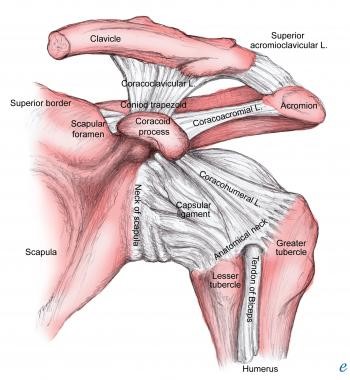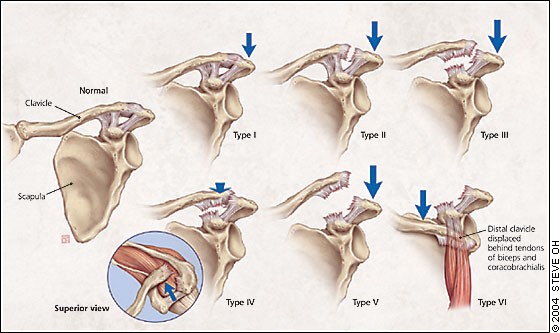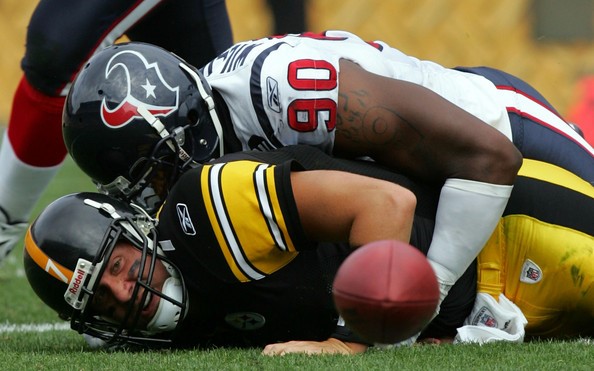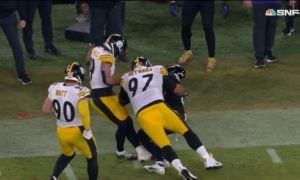We all saw it last night and couldn’t believe our eyes. With the Pittsburgh Steelers season hanging by a thread, QB Ben Roethlisberger, after sustaining a significant right shoulder injury at the end of the 3rd quarter and parked on the sideline after returning from xrays in the locker room, drove the Steelers down the field to a victory in the Wild Card round of the 2015 playoffs. And the only question Steelers fans (and Vegas) want answered right now is this: Can Big Ben play in 7 days when the Steelers face off against the Denver Broncos and Denver’s top defense?
We are waiting for news of the MRI Roethlisberger is expected to have today, but the overwhelming likelihood is that he has suffered a right AC (acromioclavicular) sprain, commonly referred to as a separated shoulder. While I have no access to his medical reports, I have to assume that the xrays performed during the game showed no fracture. The degree of the sprain is important, but we already know he can throw the ball. I have no doubt that adrenaline (and maybe a steroid shot with some local anesthetic) contributed to his late game heroics, and the swelling will be worse today. Gerry Dulac reported in the Post-Gazette that there is no ligament injury according to Ben, who also said he didn’t know the extent of the injury. So while we wait for any updates, let’s take a look at the playoff implications for the Steelers.
First, a little background on AC sprains: An AC sprain is often seen in contact sports. A football tackle, where the player lands on his shoulder, is the typical mechanism, and it doesn’t help when Vontaz Burfict, in full thug mode, puts his full body weight onto it and then grinds his knee against the joint.
So what exactly is an AC sprain? The shoulder joint is made by the junction of three bones: the collarbone (clavicle), the shoulder blade (scapula), and the upper arm bone (humerus). The scapula has a bony process called the acromion, which is attached to the end of the clavicle by several ligaments. The joint between this part of the scapula and clavicle is called the acromioclavicular (AC) joint. The rounded end of the humerus sits in this joint like a ball in a socket.
If the ligaments of the AC joint are stretched or torn, the shoulder may not function normally. The most common symptoms are pain, swelling, and decreased range of motion in the shoulder. AC sprains are graded according to the Rockwood scale from 1-6:
The treatment for a type I or II injury includes a sling, ice, anti-inflammatories, and sometimes physiotherapy. The pain usually improves quickly, but the ligament can take up to 6 weeks to heal completely. In both cases, Roethlisberger could progress to range of motion (ROM) and strength training once his pain decreased. I’m again assuming that he sustained a type I or possibly a type II sprain, or it would have been nearly impossible to do what he did. In the regular season, a player who sustains a type I sprain would be allowed to return to full physical activity once he had nearly normal ROM and no tenderness over the joint and with a type II sprain would be out of action for 6 weeks. But we all know that the rules of recovery change in the post-season…so it’s not about what Big Ben should do. It’s all about what he safely can do without risking permanent injury. I am absolutely sure that the Steelers won’t risk their 33-year-old franchise QB’s throwing shoulder, but they can’t avoid approaching a “win or go home” scenario differently than they would treat a Week 10 game. And if it is a type I AC sprain, he would be at risk for increased pain but not worsening the injury.
My money is on a type I sprain (stretching of the joint but no tear) and here’s why:
- He never had a sling, either during the game, after the game, or today at the South Side facility according to at least 2 local beat reporters.
- He said he couldn’t throw down the field…but on his last throw, he was standing on the Steelers 43 ½ yard line and Antonio Brown, the intended receiver, was on the Bengals 34 yard line. That’s 22 ½ yards, and Ben sailed it over AB’s head. So accuracy may be an issue but strength doesn’t seem to be the problem. Let’s not forget there was heavy rain as well as wind.
- Some have suggested that Ben had a stinger. But he immediately grabbed his anterior chest, which is far more suggestive of AC sprain.
The medical literature says that Big Ben will play, too. In a study on AC joint injuries in the NFL from 2000 to 2011, this is what the authors found:
- 2% of shoulder injuries involved the AC joint.
- Of the 727 AC joints evaluated, 210 were type 1 (another 319 were listed as unspecified)
- 8% of AC joint injuries were sustained by QBs. The position most likely to get an AC joint injury was defensive back (16.1%)
- In terms of incidence, QBs were most likely to get an AC joint injury (20.9 per 100 players)
- QBs missed an average of 17.3 days (this includes all types/severity)
- All players with a type I AC joint injury missed an average of 7.3 days
Jaguars QB Blake Bortles sustained a type I AC sprain on his throwing arm in a loss to Tampa Bay in Week 5 this year. He missed no time in that game and played the following week, going 30/53 for 331 yards with a long of 29 yards. His season average for longest pass in 2015 was 47 yards. He threw 3 TDs and 3 INTs in the week after his injury, but keep in mind that Jacksonville was playing the Texans, who have a pretty good defense, and Bortles TD/INT ratio up to that point was 10/4.
Colts QB Matt Hasselbeck suffered a type 1 AC sprain in the Week 16 win over the Dolphins. He was unable to play the following week. To be fair, he was beat up in so many other ways over the prior weeks and was basically walking wounded. Although the Colts had a chance to make the playoffs with a win in the final week, it was a very long shot.
Back in 2007, Eli Manning missed no playing time with a type 1 AC sprain. His shoulder injury occurred when he was sacked during an attempt at a 2-point conversion in the 4th quarter of the reigning Superbowl champion Giants home opener at their new stadium against the Dallas Cowboys, a game the Giants would lose. He was back on the field minutes later after Romo threw an INT. Starting at the Dallas 22 yard line, Manning completed 3 passes of 5, 4 and 10 yards, with the last one resulting in a TD. Manning played the following week against the Green Bay Packers, going 16/29 for 211 yards with a long of 40 yards. His season average that year for long passes was 5 yards less (35.2). And the Packers only gave up an average of 210 passing yards per game that season.
Oh, and by the way, there is one more NFL QB that had this same injury to his throwing shoulder in recent years…Ben Roethlisberger himself. He sustained a type I right AC sprain after a sack by Houston Texans Mario Williams at the Steelers home opener in 2008:
Ben missed some practice but led the Steelers to a win over the Browns the following week. His stat line wasn’t impressive: 13/20 for 179 yards for 1 TD and no INT. Then again, he was playing in winds gusting up to 60 mph. Not too shabby. His longest pass of the day went 48 yards. Yeah, it was the Browns, but that defense was only giving up 205 yards per game on average in 2008.
So is there anything Ben can do to enhance his recovery and get back on the field faster? That process has probably already started. While surgery won’t be necessary, injecting the shoulder with a combination of corticosteroid and local anesthetic can decrease pain and the amount of time the QB misses. Here’s a video on the technique for the geeks out there.
A study in the American Journal of Sports Medicine from 2010 which looked at 100 professional rugby players who received injections of local anesthetic for joint injuries showed no difference in athletic performance, but AC injuries were among the injuries where players reported the highest satisfaction regarding pain relief. A presentation by Edward Craig, MD, MPH, an internationally respected shoulder surgeon who worked at the Hospital for Special Surgery in NYC, highlighted data presented at the NFL Team Physicians Meeting that showed a faster return to playing for NFL QBs who received an injection for an AC joint injury. There was a more significant benefit for players with type II AC sprains as compared to players with a type I or III injury. But hey, any improvement in recovery time helps when it’s crunch time.
Taping the shoulder can help, too. This is typically done to add support, maintaining the joint in proper alignment. Here is a video showing one technique. Therapeutic ultrasound has been advocated by many sports injury clinics, who claim that the treatment can reduce pain and muscle spasm and promote the healing process. It hasn’t been proven but has no major side effects and is considered to be safe in this scenario. Obviously (yeah, I said it), anti-inflammatory medications can give pain relief as well.
The key for Ben will be strength and accuracy, not pain. He has dealt with worse injuries to his throwing arm from a pain standpoint. Remember that crazy SC joint and rib injury he suffered in 2012? That one would definitely hurt a heck of a lot more. He returned after missing only 3 games to throw for 285 yards with a long of 40 yards for 3 TDs and 1 INT against a San Diego team that gave up 230 passing yards per game that season.
The discussion of Roethlisberger’s shoulder injury will likely reach hysteria in the sports media by tomorrow; he is the franchise QB of a team with a legitimate chance to make it to the Superbowl and even win it all, heading into a tough matchup against a talented defense in Denver. I’m sure that we won’t have an answer about whether Big Ben will be the Steelers starter until gameday. But based on what we saw in Cincinnati last night, I will expect Ben to play. And play well. He won’t be at his best, but I believe he will give the Steelers their best chance to win, and that is the simplest basis for the decision that HC Mike Tomlin will make. Just like he did last night. And Ben came through when they needed him most. Expect him to do it again in 7 days.











